Page Under construction!
Colorado Springs Notes - August 1-31, 1899
http://www.bibliotecapleyades.net/tesla/coloradonotes/coloradonotes06.htm#Colorado%20Springs%20Notes%20August%201-31,%201899
For want of time following items, partly worked out, have been omitted:
Aug. 4. General observations of electrical phenomena here with particular reference to stationary waves.
Aug. 6. Experiments with stationary waves on water pipe.
Note: Distance from ground-plate to end of main exactly 550 feet.
Aug. 31. Patent matter worked on:
1) Production of stationary waves and use of same in general
2) Distribution of universal time observatories etc.
3) Indication of direction for ships etc.
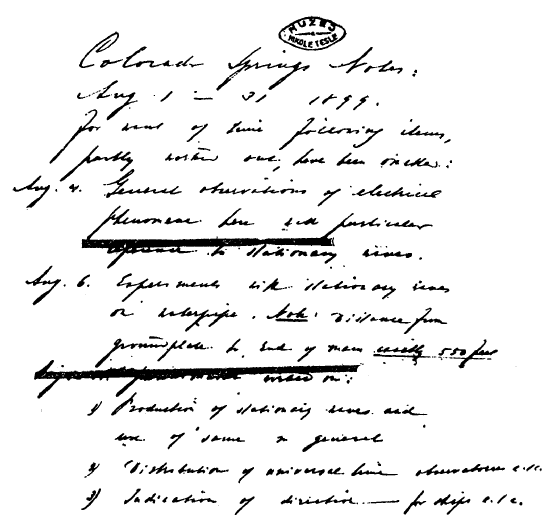
Colorado Springs
Aug. 1, 1899
Various observations.
In the course of these experiments and particularly during the past month a number of highly interesting observations have been made which will
be presently dwelt upon.
First of all one is struck by noting the extraordinary purity of the atmosphere which is best evident from the clearness and sharpness of outlines of objects at great distances. In' low regions,
especially where moisture is in excess, the outlines of objects become more or less indistinct and confuse at distances of but a very few miles while here at many times such distances the
outlines appear perfectly clear and sharp.
When a train is moving up Pike's Peak it is very often quite easy to distinguish not only the engine and cars but even the windows and wheels of the same perfectly, although the distance from the experimental station is from 10—12 miles. Quite frequently also the house on top of Pike's Peak can be clearly seen with the naked eye. The ranges of mountains 100—150 miles away or more can be perceived perfectly.
A range at a distance of about 50 miles can be seen plainly even at night when the sky is clear. It is wonderful how at times immense objects
appear dwarfed, while small objects as horses, carriages or men assume unnatural gigantic dimensions.
Pike's Peak Range appears at times so close and so ridiculously small, that anyone not knowing the reality would be apt to fire a modern rifle at some object on the mountainside believing it to
be within shot. Nor is this statement exaggerated much as it seems so. At other times again Pike's Peak appears far remote and its height much beyond what would seem natural.
The arc lamps at the foot of the mountains five to seven miles away or more shine with a brilliancy as though they were only as many blocks from
the observer and under certain conditions an ordinary incandescent lamp of 16 c.p. seems to give out as much light, judging from a distance, as ordinarily an arc light does. It appears also as
big as the latter. This penetration of the light is due to the wonderful purity and extreme dryness of the atmosphere.
The moonlight is of a power baffling description. I have been told that the best photographs of the mountains have been obtained by moonlight and I do net doubt it. Exposures of half an hour
ought to give clear photographs revealing all details although the exposures are as I am told from 1 1 /2 to 2 hours. I have nowhere seen such a light. Italy is famous for moonlight nights but in
my estimation that country can not even compare with Colorado.
I think this extraordinary brightness of the moonlight is chiefly due to the absence of moisture, for there are many places, as in Central America, which are located much higher and yet the moonlight, I am told, is not so intense and I can see no other reason for this except the presence of more vapour in those places. It is not a mere saying, but literally true, that during full moon in these parts it is "as light as day". Objects can be clearly perceived at distances of many miles and one can easily recognize a friend or familiar object at a distance of something like a quarter mile if not more.
The shadows cast by the moonlight are extraordinarily black and sharp. They suggest the Crockes' shadows noted in vacuum bulbs and on this account the moonlight is particularly interesting and suggesting thought and stimulating the imaginative powers. The shadows of the clouds on the plains and mountains are quite dark and clearly defined and it is interesting to behold the patches as they speed over the ground. When the moon is absent and the nights clear the number of stars visible and their brilliancy is amazing and the sky presents a truly wonderful sight.
The twinkling of the stars is very pronounced, they seem to move in orbits of as much as ten or fifteen of their own diameters across. At times
one observes a star burst out into great brilliancy. This is probably due to the removal of an invisible cloud or of a layer of air at a great altitude containing some kind of particles which cut
off a large portion of the light. One sees shooting stars quite frequently, also colored rings around the moon, generally in the advanced hours of the night, at times when the air is slightly
misty. As this happens generally during very cold nights I believe the colored rings are due to minute crystals of ice.
O^ingto the extraordinary purity and dryness of the atmosphere the sounds penetrate to astonishing distances. This is particularly true of high notes as nearly as I can judge. Certain conditions,
entirely exceptional, concur at times and produce effects of this kind which are startling. A bell will ring in the city several miles away, and it would seem as though the bell would be before
the very door of the laboratory.
During certain nights when sleepless I have been astonished to hear the talk of people in the streets and sounds of this kind in a large radius around the dwelling not to speak of the grinding of the wheels, the rolling of wagons, the puffing of the engines etc. which are perceptible in such a case, and with painful loundness though coming from distances incredibly great.
These phenomena are so striking that they can not be satisfactorily explained by any plausible hypothesis and I am led to believe that possibly
the strong electrification of the air, which is often noted, and to an extraordinary degree, may be more or less responsible for their occurrence.
The dryness of the atmosphere, which is still further enhanced by the low pressure, is such that wood or other material is made what is called kiln-dry inside of a few hours, and is rendered an
insulator far more perfect than wood is ordinarily. The nails on the hands and toes dry out to such an extent that they break off very easily, in fact one has to be careful in trimming them. I
found the claws of a cat as brittle as glass.
The skin on the hands dries out and cracks up and is apt to form deep sores particularly if, as often in experimentation, one has to wash the
hands frequently. The hair gets perceptibly thinner owing to the drying out. Colorado is not a good country for hair. This may be of interest to people with a tendency towards baldness. People
even very sick do not cough and expectorate evidently owing to the dryness of the atmosphere. One does not perspire as the sweat is immediately evaporated. It is curious how quick the body gets
dry when a bath is taken. Still more this is noted when the body is rubbed with alcohol. These observations are not often made, unfortunately, as the opportunities for comfort are not such as one
might desire.
In many respects one is disappointed with the aspect of the country itself although it is far famed. I think it very uninteresting and even the celebrated Pike's Peak is insignificant. Most of
the country is barren, practically a desert, with little vegetable and animal life in places. Prairie dogs are about the only animals one can see on the plains. One rarely sees a bird and the
country must be a tedious one to live in for any one with tastes for hunting and fishing.
But as much as the country is devoid of interest and beauty, so much and far more, is the sky beautiful. The sights one sees here in the heavens are such that no pen can ever describe. The cloud formations are the most marvelous sights that one can see anywhere. The iridescent colors are to my judgment incomparably more vivid and intense than in the Alps. Every possible shade of eolor may be seen the red and white preponderating.
The phenomena accompanying the sunrise and sunset are often such that one is at the point of not believing his own eyes. At times large portions of the sky assume a deep red almost blood-red color, so intense that superstitious people might will be frightened when first seeing it as by some other altogether unusual manifestation in the heavens. Sometimes, particularly in the forenoon, huge masses of what appears to be snow are seen floating in the air and they are so real and tangible, so sharply defined, that it is difficult to believe them to be composed merely of vapor.
The purity and dryness of the atmosphere explains to a degree the sharpness of definition of the boundaries of these formations of mist, but it is quite possible that some other causes as electrification of the particles cooperate in rendering them so compact as they appear to be.
Of course, the purer the air, the greater is the difference between the region filled by cloud and that surrounding it as regards the passage of light rays, and the boundaries of the cloud appear sharper and quasi-solid much on this account. The whiteness and purity of these masses of cloud is such that one has the idea that nothing, not even an angel, could come in contact with it without soiling it.
Very often when the sun is setting, a considerable portion of the sky above the mountain range presents the sight of an immense furnace with white-hot molten metal. It is absolutely impossible to look at the melting away clouds without being blinded, so vivid is the light. On a few occasions I have seen the mountains covered with a white silvery veil most beautiful to see, an unusual occurrence and caused by a fine mist-like rain in the mountain region.
The intensity of the light on these occasions was really wonderful. What was remarked before of the shadows of the moon is, and to a much greater degree, true of those thrown by the sun. They are ink-black and sharply outlined. The shadows on the plain and mountains thrown by the clouds appear like big patches of inking blackness hurrying along the ground. Particularly interesting are shadows thrown across the sky resembling often large dark streamers, or those which under certain conditions are formed and are visible like dark columns extended from the ground to the sky.
These shadows seem to be best visible in the middle of the afternoon or a little later when the sun in fairly down and on days when it has been
extremely hot and sultry in the forenoon and the clouds are formed quickly and are of greater density than usual.
A very curious phenomenon is the rapid formation and disappearance of the clouds. One can watch them continuously forming and disappearing rapidly and one merely needs to turn away for a few
moments when he may see that the aspect has changed, new clouds having replaced those he saw before. On many occasions, just after sunset, I have seen seemingly dense, white clouds appear as by
enchantment below the mountain peaks. So quickly did these clouds or mist form that their appearance was much like the projection of an image on the screen.
The wonderful beauty of the cloud formations as seen here is, however, enhanced not only by the incredible sharpness of the outlines and vividness-of-color but also by their accidental arrangement and forms they assume. Not infrequently one can see clouds resembling all kinds of known objects, this adding much to the enjoyment one finds in observing them. In fact I have scarcely ever watched the clouds here without noting among the shapes resembling some or other familiar object. It is probably owing to the peculiar character of the clouds here that phenomena of this kind may be almost daily observed whereas in other parts they are very rare.
Very often I have seen low on the horizon what appeared to be immense fields of ice as a sea frozen in the midst of a storm but so wonderfully real that it would be impossible to give an idea of it by a description however vivid. At other times there appeared ranges of mountains which one could not distinguish from the actual, on the horizon or the wide ocean, with its deep green, or dark blue, or black waters stretching out as far as the eye could reach.
Nor was this an ordinary resemblance which one could banish from the mind by a small effort of will, but was rather of nature of those visions or hallucinations which make it necessary for one to
pinch himself to fully realize that his senses have been deceiving him. More than once I have seen this ocean dotted with green islands or populated with glittering icebergs or sailing vessels or
even steamers not less real to the eye because they were formations of mere mist or cloud.
Almost every evening, after sunset, and when the sky is clear, the horizon towards the plains becomes peculiarly tinged with colors of surprising vividness, all the colors of the rainbow being
represented), the strata higher above the horizon beginning with red and passing through all nuances, the lowest strata finishing with blue, violet and black. As it grows darker the black line
rises continuously above the horizon.
This phenomenon illustrates in an interesting manner how the sun's rays are deviating from the straight course and are being continuously deflected downwards to the more dense strata of the atmosphere. Among the seemingly infinite variety of clouds there are four typical forms regularly observable which are of surpassing beauty. They are:
1) Red clouds, which are seen very frequently in the early morning hours at sunrise and, though less frequently, in the evening when owing to a
greater percentage of moisture the clouds are denser, more like rain clouds. They reach an intensity^of color equal to that of a ruby of the "pigeonblood" species. They are particularly beautiful
when appearing in detached masses.
2) White clouds which are seen chiefly in the forenoon or in the early part of the afternoon though not so often. The whiteness and purity of these clouds and their sharpness of contours which
has been already referred to makes them a unique sight. It would be difficult to offer to the eye a greater treat than it finds in the contemplation of these masses of mist, generally floating in
big detached lumps in the blue sky. I note that these clouds are seen generally after a short rain when the wind, springing up suddenly, clears the sky, leaving only a few large and separate
masses of vapor.
3) Clouds presenting the appearance of immense lumps of gold. These are iridescent clouds witnessed chiefly at sunset. They present a striking sight, particularly when they are small and detached
from each other and the sun's rays can penetrate them more freely thus heightening at times to a degree really incredible the intensity of the iridescence. Their color is absolutely like that of
gold and the similarity is rendered complete by the forms they assume which are those of gold nuggets found in nature, but generally they pass from pure yellow to a reddish yellow of the kind
peculiar to gold found in certain countries or generally gold containing a small percentage of copper.
A feature of these most beautiful clouds is that they persist in their iridescence but a very short while. Usually they last only from five to
ten minutes and often even not so long, although the yellow color may generally persist on the edges for as much as half an hour, more so in the morning than in the evening hours.
4) Clouds resembling lumps of incandescent metal. These clouds are most wonderful to behold and the intensity of the light emitted by them is such that it baffles description. I have never before
seen anything of this kind in the Alps or elsewhere. One can see all nuances of color exhibited by heated metal or coal, from dull red to blinding white incandescence such as is seen in silver
furnaces known in German as the "Silberblick".
But most generally these clouds present the appearance of lumps of glowing coal surpassing, if anything, the latter in brilliancy and intensity of color and the sense of sight is still more completely deceived by the gradual burning away of the glowing mass offering to the eye the spectacle of a mass of charcoal which is being quickly consumed in a furnace with a very strong draught.
How can the intensity of the light emitted by these clouds be explained? They throw out at times a light which to the eye is as intense and blinding as that of the sun's disk itself, yet they present a surface many hundred times greater than that of the sun's disk.
Is it not possible that in this intense iridescence, not to say incandescence, we see not only a phenomenon of reflection and refraction of the rays of light but also, at least partially, of conversion of dark radiations of the sun into such which cause in our eye the sensation of light? Or, if not exactly this, might it not be possible that the dark rays being absorbed in the mist in some way or other reduce the absorption of the light rays and render the process of reflection and refraction of the latter more economical?
I can not recollect any experiments carried on with the object of ascertaining the influence of temperature on these processes. A hot glass lens ought to be more efficient in letting the light rays through than a cold one. But, reasoning in the same strain, it would appear that reflection from a surface ought to be impaired by heating the latter.
Furthermore I should think that it can not be indifferent for these two processes at what temperature the body reflecting or refracting the rays is maintained, at least one must infer so from the accepted theories according to which the dark and luminous radiations merely differ in their wave lengths but are otherwise identical.
The most plausible view on" the above phenomenon still seems to me that first expressed, according to which invisible radiations are partially converted into luminous rays or radiations thus supplying the additional light which it is difficult to account for otherwise. It is not impossible that a phenomenon similar to fluorescence might be produced by heat rays falling upon the particles of mist thus heightening the light effect or there may be caused, by the dark rays, a decomposition or falling apart of the vapor particles (as Tyndall demonstrated) — and this process may be accompanied by some evolution of light.
Certainly the particles capable of producing such vivid iridescence must be very minute, much smaller than ordinary particles composing the clouds and their form can not be but a passing one as is evidenced by the rapid disappearance and reappearance of clouds already mentioned. These four types of cloud, which can be observed here almost daily and which in purity, brilliancy and depth of color and sharpness of outlines surpass by far such clouds noted in other parts, constitute the chief attractions of the incomparable beauty of this sky.
These phenomena would be more appreciated if they were more rare, but the fact is that for most people they loose a large portion of their charm by forcing themselves upon the eye too frequently. We are used to speak of "Sunny Italy" but compared with Colorado that country might be almost likened to foggy England. They tell me that there are scarcely 10—20 days in a year, on the average, when the sun does not shine and even this estimate is rather exaggerated.
Since my arrival here about the middle of May, with the exception of a few passing thunderstorms, the days were clear with just enough clouds in
the sky to break the monotony of the blue.
No wonder that consumptives and generally people in feeble health are getting on here so well. The purity of the air, the altitude, which compels exercise of the lungs to be continuously and
unconsciously practiced owing to the lesser density of the air and smaller percentage of oxygen (about 20% less than at sea level), the dryness of the air which is altogether exceptional, all
these causes may cooperate more or less efficiently in improving the condition of the patients, but I believe that the chief cause of betterment is to be found in the profuse and cheering
sunlight.
Whether the light produces a specific germicidal effect is a matter of conjecture as yet, as far as I know. I learned here that experiments had been carried on to ascertain whether there are any Roentgen rays emitted by the sun or produced in other ways by the sun's rays but the results were negative.
Similar experiments, I am told, were conducted for a long period on Pike's Peak but-no action on a photographic film, which was the means of these investigations, was noted, at least not such as might be attributed to Roentgen rays. I think though that rays of this kind must be ultimately demonstrated to exist in the radiations of the Sun as well as of most other sources of intense light and heat. It is possible that such rays are, in a measure, active in arresting the process of decay caused by the bacillus. I conclude that, since the bacillus of tuberculosis is an organism developed under exclusion of light, such rays of short wave length, made by any means to penetrate the tissues and reach the affected parts of the same, must needs be inimical to the development of the microbes not used to such rays.
Though this conclusion might not prove true, still there is a good foundation for it, and I am hopeful that with the apparatus I am now perfecting for other purposes as well as this, it will be possible to produce Roentgen rays of great intensity which will furnish the long sought for means of successfully combating these dreaded diseases of the internal organs. Whatever be the cause of the marvelous improvement noted in patients it is a fact that most people afflicted with these ailments, and often pronounced beyond medical help, recover and get soon seemingly quite well here.
A short while ago I was induced by a friend to go to a dinner he gave in my honor where I met a number of more or less interesting people. The conversation during the entire evening was an animated one and the entertainment highly enjoyable. Everybody seemed to be in high spirits and excellent health.
But my pleasure was spoiled in the end when I learned before parting, with painful astonishment, from a friend who is a very skilled and competent physician, that of the two dozen people I met scarcely one individual had more then one whole lung left, the majority of them being in fact "much farther gone" as he said, so that they would infallibly die in a very short time if they would leave here. I soon learned that there were thousands of consumptives in the place, about the only healthful people being coachman, and I concluded that while this climate is certainly in a wonderful degree healthful and invigorating, only two kinds of people should come here: Those who have the consumption and those who want to get it.
That the sun's light and heat exercise a highly beneficial effect on these sick people may be inferred with certainty from its effect upon people who are quite well. It is curious to note how agreeable and indispensable the sunshine becomes here after a while. Even healthful people become sad and unstrung when the sky gets clouded and dark.
I have however, observed such an effect before but it is quite natural that it should be so here where the sun shines constantly day after day. I do not suppose that in London or even in New York, where the weather is comparatively fair much attention is paid as to whether the sky is clear or clouded, but here every laborer laments when the sun does not shine. Despite the beautiful spectacle offered by the parting sun one feels sad when its disk sinks behind the mountains and one is thoroughly glad to see it rise again.
These feelings are experienced, of course, everywhere, but somehow they are of greater intensity here than elsewhere. Considering the elevation, the small density and exceptional purity and extreme dryness of the air, the scantiness of the vegetation and particularly the scarcity of protecting timber, the vastness of the practically desert prairies over which the wind can sweep unimpeded, the geographical position of the country and other causes and conditions determining the character of the climate it is not difficult to guess the general nature of the weather in Colorado.
Nevertheless it is a surprise to learn that the climate is mild in an extraordinary degree, the storms coming but seldom and lasting one or two
days at the most, the snow remaining scarcely over more than thirty-six hours on the ground.
In fact Colorado people seem to be particularly proud of their winter climate. lex-pressed to a friend my delight at the wonderfully fine and bracing weather we had so far, but he astonished me
by saying:
"This is not a fair opportunity to judge. To form a correct opinion of the qualities of this climate you must come here in wintertime".
I could scarcely conceive how it could be possibly finer and more agreeable then so far experienced. I expect to get data as to the pressure, temperature, moisture etc. The pressure at present is about 24" average, considerably less than at sea level but, owing to the bracing air, one does not feel much the effect of the rarefaction of the atmosphere except when performing some physical work, when one gets quickly out of breath.
The humidity must be extremely small otherwise one would feel both the heat and cold much more. The mean temperature presently at noon is about 80° in the shade but in sunshine it is different. I believe the good people here are more or less inclined to find the days in summer cooler than they are in reality, and they seem also to prefer to be silent about cold snaps which occasionally come in wintertime. But from some indiscreet persons I have learned that the thermometer was at times very near 40° below zero and in the plain sunshine of summer it is apt to be "way up" as my informants told me. I feel sure it can not be far from 150°.
The power of the sun's rays on certain days when the atmosphere is particularly calm, dry and pure, is such as to positively surpass belief. The waterpipe passing for some distance across the field to the laboratory being partly uncovered the heat was as a rule so fierce that the water came out boiling and steaming like in a Russian bath. It would be impossible to hold the hand in it, even for a few moments, for it would at once cause a severe pain. One day, about five o'clock in the afternoon, the rays fell through the open door on a high tension transformer which I had brought from New York and, before anybody could notice it, melted out all the insulation, rendering the apparatus completely useless.
I observed the danger a few days before and warned the assistants to watch the machine, but unfortunately on that day the usual precautions were omitted. Several barrels filled with concentrated salt solution were placed outside of the laboratory, and the pressure in them rose every day as in a steam boiler, and a few of them were damaged! When the cock was opened the water squirted out to a great distance across the field and it was thought advisable in order to avoid bursting and damage, to leave a small opening in the barrels for the escape of the steam.
The most astonishing experience of this kind was, however, the heating of a wooden ball covered with t .ifoil, which was supported above the roof, to a point it was deemed unsafe to expose it to the sun's rays. It emitted a dense vapor actually like smoke, and the tinfoil crumbled away! This excessive heating seemed to take place suddenly,.. I believe that it occurs when, owing to the removal of a layer of impuie air, a particularly clear path is opened for the sun's rays, which then pass through the pure medium without much loss.
Often I have felt a scorching pain on the cheek or neck to come on suddenly when working in sunshine, and I can only explain it with the above
assumption. But the most interesting of all are the electrical observations which will be described presently.
Colorado Springs
Aug. 2, 1899
New induction coil for portable apparatus, designed for investigation outside contained in box. Condenser method. Particulars: Secondary wound with wire No. 30, 32 layers plus one layer with
thick cord. Turns 180 per layer.
Total number of turns 5670. Least turn 1.25X7t=? longest turn 3.5 7r=? average 2.125XTC=6.675" or 17 cm. approx. for average length of one turn. Resistance of secondary 375 ohm. The dimensions of spool are as in sketch below.
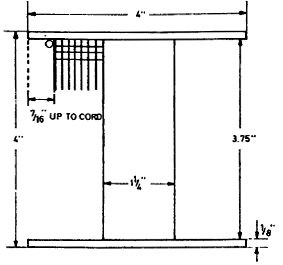
The available length of coil 4" — 1/4 for two fiber flanges l =3.75". The primary 50 turns as a coil before wound cord No. 20, Res=0.51
ohm. The length of average turn 10.6"=26.93 cm. Total length of wire in primary 530"= 1346.2 cm.
In connection with this there is to be used: a condenser to be adjusted, a charging coil experimental like wire to be adjusted to the condenser and break a Thomas clockwork with wheel 180 teeth
for break, the arbor carrying also a sensitive device so that same clockwork will serve for break and first sensitive device.
A second sensitive device in secondary of oscillating transformer driven by another Thomas clockwork. This latter need not be used when
self-exciting process with condenser employed. Relay brought from New York 996 ohms or thereabouts. This final.
Maniton bottles to be used compared with Champagne bottles. The latter would seem to be better suited. The tests showed as follows: Comparing 2 bottles of each kind filled as far as practicable
and placed in tank with rock salt solution as in previous instances charged to same potential 356 volts approximately, the average of four readings was for: Maniton bottles 13° defl. for
Champagne bottles 9.5° defl.

These figures give a slight advantage to glass in Champagne bottle, but the latter was larger than the Maniton about 1/4" outside and contained
a trifle over one quart. Furthermore, there is the usual hollow bottom (to deceive customers) and this increased the surface in the Champagne bottle. In view of this the conclusion is that the
glass is not greatly different in respect to dielectric qualities in both the bottles. The Champagne bottle would unquestionably break down first because of hollow bottom, as it would be
difficult to exclude the air. It would also be difficult to get the required number of such
Consider the following case: A condenser is connected in series with another to a generator of high tension. A circuit making and breaking device is arranged in a bridge between the condensers as
illustrated in diagram. When the circuit is closed through this bottles in this quiet town. This compels use of Maniton.
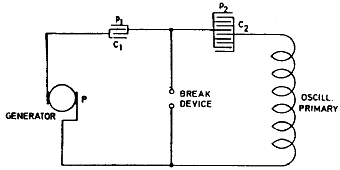
Consider the following case: A condenser is connected in series with another to a generator of high tension. A circuit making and breaking device is arranged in a bridge between the condensers as illustrated in diagram. When the circuit is closed through this device the condenser included in the circuit of the generator is charged to the full potential, but when the device breaks the current path, the charge is distributed over the two condensers.
Such an arrangement with two condensers has certain valuable features in connection with oscillators, particularly when they are worked from a generator-of very high and constant e.m.f. The condenser included in the generator circuit prevents short circuiting of the generator in case of defective action of the make and break device and the amount of energy drawn from the source is limited to a quantity which can be exactly determined beforehand. The arrangement is sometimes of value also with alternate current generators.
The condenser C, then performs the function of a reducing valve on a reservoir such as is used in connection with a distribution system of some gas under great pressure. By means of such an arrangement an oscillator may be worked safely from a generator of any e.m.f. and at any desired pressure. In the case as illustrated the total capacity is
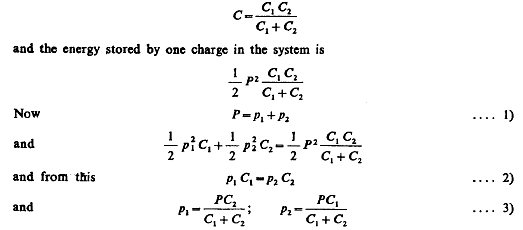
Suppose the process be such that C1 first be charged to full pressure P and then disconnected and charge distributed over the two condensers, C2 being the condenser belonging to the oscillator,
whereas C1 is the regulating condenser, then since

is the pressure on condenser C, which it was the object to find.
Colorado Springs
Aug. 3, 1899
Modifications of apparatus, involving condenser method of magnifying effects, experimented with "Self-exciting" process.
In this special modification of condenser method, an effect produced upon the sensitive device is rendered accumulative not only as in some other modifications, but more so by a process
comparable to the self-excitation of a dynamo. Thus much feebler initial effects are made sufficient to cause the sensitive device to break down and the receiver to be operated. This process
accomplished ii« this manner will certainly have many valuable uses. A few arrangements which have been experimented with are recorded below. They are self-explanatory.
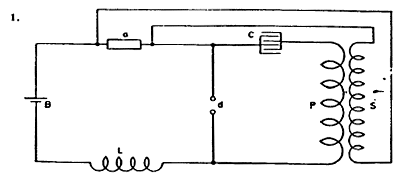
The lettering makes Diagram 1. fully clear with reference to previous diagrams of this kind, a is the sensitive device, d a make and break device, Ca condenser P the primary and S the secondary
of oscillatory transformer, B a battery and L an inductance suitably adjusted.
The sensitive relay usually employed may be in the circuit containing battery B, inductance L, and the devices d and a; or, it may be in the circuit of secondary S and device a in which case this circuit will contain an additional battery. There will also be in the circuits the usual adjustable resistances to adjust the instruments and insure the best action.
From the diagram it will be easily seen that when the device a is at first very slightly affected, the condenser is charged more and the secondary currents become more strongly excited in their turn, the device and so on, until the device breaks down and diminishes sufficiently in resistance so that the relay is operated.
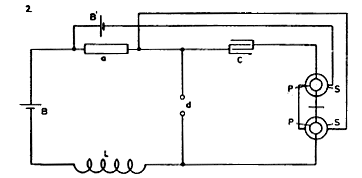
This method has been found excellent and will have besides telegraphy many valuable uses since by its means effects, too feeble to be recorded in other ways, may be rendered sufficiently strong to cause the operation of any suitable device. A number of modified arrangements as have been experimented will now be recorded.
Referring to diagrams which follow in Fig. 2. an arrangement identical with that in Fig. 1. is shown, only the relay itself is made to be the transformer by being suitably proportioned to the break and condenser and having on top of primary windings P P a secondary S S wound with fine wire and containing a battery B' as shown.
The secondary excites the sensitive device a until it breaks down when the relay is operated. This arrangement is not the most preferable to employ as better results will be obtained with an independent transformer and relay, but it has the features of compactness and simplicity. It can be, however, still further simplified by doing away with inductance L.
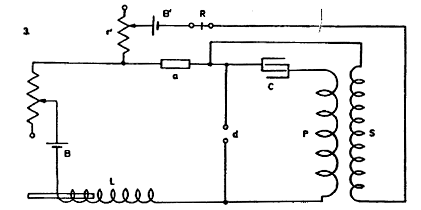
The batteries B and B' may be connected to cooperate in their acts upon sensitive device a or to oppose each other. The former seems preferable. The condenser should be of large capacity. In Diagram 3. the form of connections is illustrated which was found most convenient for experimentation.
An independent sensitive relay is used and adjustable dead resistances r and r' in primary and secondary circuits. The inductance L is also made adjustable and so is also break device d though this is not indicated in the diagram.
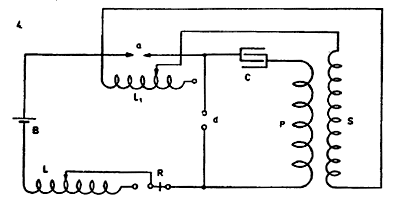
In Fig. 4. again plan is shown which is suitable when, instead of a sensitive device as has been described before and which is based on the properties of minute conducting grains, a minute gap a is employed. This special device comprises two points almost in contact and in an atmosphere or medium the insulating properties of which are impaired to such an extent that it breaks down readily upon a slight increase of the electrical pressure.
The additional adjustable inductance Lx serves to bridge the gap and allow normally a small current to pass and to charge condenser C, to strain sufficiently device a. The relay R may be otherwise placed.
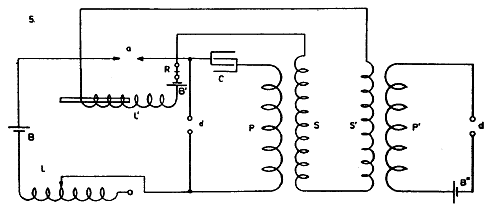
Finally, in Diagr. 5. a modification is shown with an additional induction coil P'S', B" and d', the latter device making and breaking the
circuit and straining device a by currents generated in secondary 5". The diagram is otherwise self-explanatory. The relay may be, as stated before, otherwise inserted.
Colorado Springs
Aug. 5, 1899
Experiments with condenser method of magnifying effects continued. More of the modifications described: In Diagram 1. a resistance, preferably inductive, is placed around sensitive device a for
the purpose of regulating the charge of condenser C and thereby determining the degree of excitation of device a' in secondary circuit of transformer.
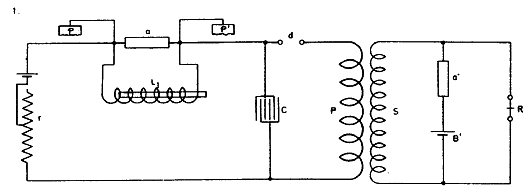
The adjustable resistance r serves to regulate strain exerted upon device a by battery B. The terminals or plates pp' are placed in suitable locations of medium or media, one in the air, the other in the ground generally. Otherwise the diagram explains itself.
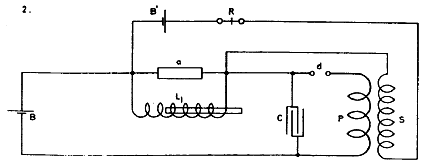
In Diagram 2. the second sensitive device is omitted and the secondary S is connected around sensitive device a. Other accessories, as
adjustable resistances, are likewise omitted for sake of clearness.
In Diagram 3. again the coil L is made the secondary of another coil which is supplied from primary oscillating transformer P S, the latter being controlled in its performance by sensitive device
a.
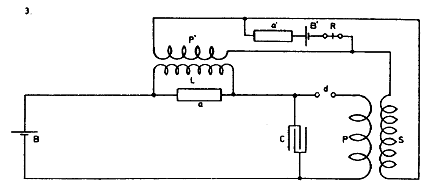
In Diagram 4. a similar arrangement i$ illustrated as shown on a previous occasion, the secondary S being connected around sensitive device a and containing another sensitive device, relay and battery, other accessories being omitted for reasons above given.
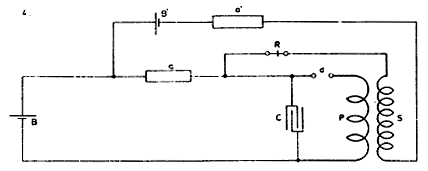
Colorado Springs
Aug. 6, 1899
Experiments with Condenser method of magnifying effects. More of the arrangements experimented with described:
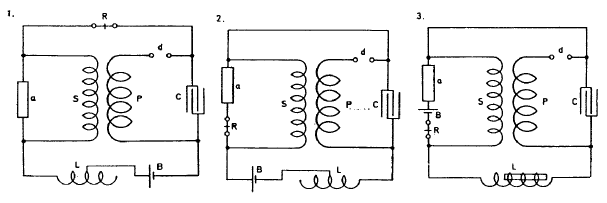
The three diagrams shown illustrate arrangements as variously carried out in a form of portable apparatus referred to before. Referring to Fig. 1. the sensitive device a was one consisting of a small glass tube and two metalic plugs, the tube being rotated by a Thomas Clockwork.
Coarse nickel chips prepared as before described were used in the tube. An improvement was effected by cleaning the chips first with dilute acid and alkaline solution and destilled water and alcohol at the last. In one apparatus the plugs were 1 /8" apart, tube 1/4" diam. half filled. Condenser 1/2 mfd. one of the small ones before used. L, S, P and d were as described on another occasion. The results were good.
In Diagram 2. the same devices were used in a slightly different way as will be plain from the diagram. The receiver R was put in series with device a so as not to be affected much by operation of break device d. This seemed better, results are very satisfactory. In Diagram 3. the improvement was carried still further the same devices being again used.
The delicately balanced lever of receiver R was very little affected by the sudden action of the break, the pull was steady in consequence and a
better adjustment was possible. The results were now most satisfactory. One cell of Leclench6 dry being quite sufficient.
Evidence of stationary waves water pipe
Colorado Springs
Aug. 7, 1899
Some dispositions of apparatus experimented with in which the secondary of an oscillating transformer was used to excite the sensitive device have shown results vastly better and it seems that
the increased sensitiveness is due partially at least, to the fact that one terminal of the secondary connected to a sensitive device (which unexcited has a resistance of about 100,000 ohms or
more) is practically open and that therefore by the slightest disturbance a high pressure can freely manifest itself and break down the insulation of the device.
To investigate further the capacity of such arrangements a great number were tried of which some follow: One of the earlier arrangements was as illustrated in 1.
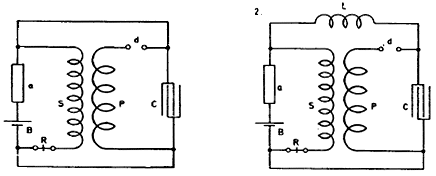
In this case the secondary S was closed by the condenser C too large for it, and the self-induction (very large) L was inserted to overcome this defect and for other reasons (2).
The next arrangement adopted was as shown in 3. In this case the terminal of secondary, or respectively its continuation up to / was open or insulated — at least practically so and the apparatus
was more sensitive when the secondary had a great number of turns, it was better to place battery B and receiver R between the other end of secondary and the corresponding terminal of the
condenser, but when the secondary did not have as many turns the apparatus generally worked better with battery and relay placed as shown in 3. as they caused a certain rise — by their capacity
and self-induction — of the electrical pressure on terminal / of sensitive device.
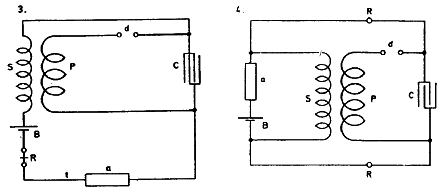
A modification of Fig. 2. is shown in Fig. 4. In this case the self-induction L was replaced by relay R R which had one of its legs or coils inserted in each of the two branches of the circuit leading from the condenser as illustrated. As the relay had a very high winding and high resistance nearly 1000 ohms, this left the secondary practically opened and free to work on sensitive device a.
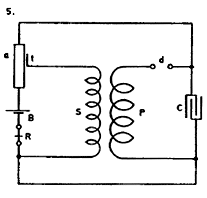
It was observed in some experiments that a sensitive device becomes more responsive to feeble disturbances when, instead of being excited by direct connection to a source, it is strained from a source from some distance. In some instances the apparatus was affected and the relay responded to a small bell from a great distance.
It is probable that the increased sensitiveness is due to a certain freedom or looseness of the grains of nickel which were used and which does
not exist to such extent by direct connection to a battery. These observations led to investigating the capacities of some such arrangements typically illustrated in Diagram S in which the device
is excited by induction.
Colorado Springs
Aug. 8, 1899
Other ways of connecting apparatus when using open acting secondary for exciting sensitive device.
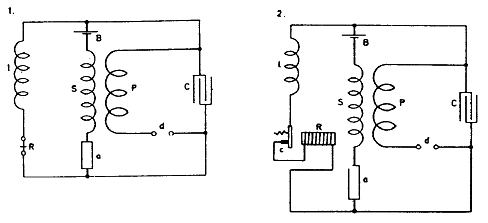
As in some previous experiments the fine relay R was affected by the break d, the relay with an adjusted high ohmic or inductive resistance / was placed in a special branch circuit (1.)
It being found, furthermore, that when the sensitive device is very delicately adjusted, it often would not loose the excitation quickly enough
by rotation (when a rotating cylinder as often experimented with before was used), but it would always loose the excitation by breaking the battery circuit — the disposition illustrated in 2. was
adopted in which the relay R was made to break the battery circuit by opening contact c which was fixed similarly to that of an ordinary bell or buzzer with a fine spring so that the relay could
complete the contact underneath (not shown) working the printing apparatus or other appliance.
The under contact was, however, dispensed with by connecting around contact c a circuit of very high resistance including another fine relay which was brought into action whenever the lever of
relay R was pulled toward the core.
Instead of using the clockwork with break before referred to, an ordinary magnetic circuit breaker with contact was employed to operate the primary P and to generate thereby the currents in
secondary S for excitation of device a. This simple arrangement is shown in Diagram 3. To provide for excitation of condenser and consequently of sensitive device up to the point desired various
plans were investigated of which some follow here:
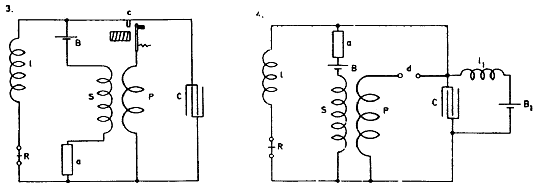
In Fig. 4. for instance, the resistance of device a unexcited being practically infinite an other battery Bx with self-induction coil /, v/as placed around the condenser to excite the same and by the action of secondary S also sensitive device a.
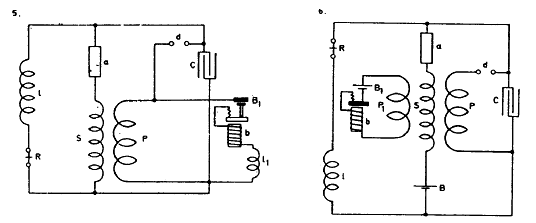
Again in Fig. 5. around the ends of the primary P was connected a Battery B1 in series with buzzer b and adjusted self-induction
l1 The latter was so graduated that the induced currents in S would strain the device a to the point of breaking down* Still another such plan was tried by placing a separate circuit
comprising coil P, Battery B1 and buzzer b at a suitable distance of secondary S, such that the preparatory excitation of device a was effected.
Colorado Springs
Aug. 9, 1899
Other dispositions of apparatus experimented with. One of the plans before described was modified in the manner illustrated in 1., the battery Bx which effected the preparatory excitation being
placed as indicated so as to work through the primary P and conjointly with main battery B.
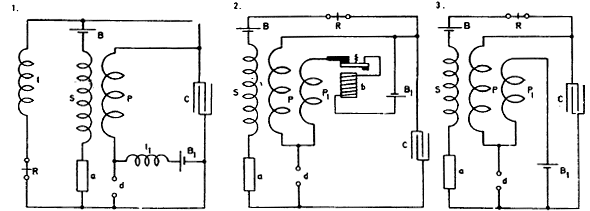
Fig. 2. illustrates a disposition similar to one experimented with before, only in series with buzzer b and auxiliary exciting battery B1 a primary which was adjustable (P1) was used. This arrangement was modified to the one illustrated in Diagram 3. The intention being to use the same break for both primaries P and P1.
Neither of the plans (2 and 3) seemed capable of such results as were readily obtained in some previous dispositions. These experiments showed that the proper way was to modify plan 3 into one illustrated in 4.
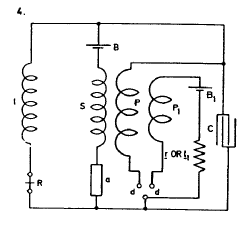
In this case a break device with two contacts is provided which make and break simultaneously both the main primary P and auxiliary primary coil
P1 In auxiliary circuit P1, for purpose of adjustment, a resistance r or l dead or inductive is included.
Colorado Springs
Aug. 10, 1899
Further modifications of apparatus experimented with.
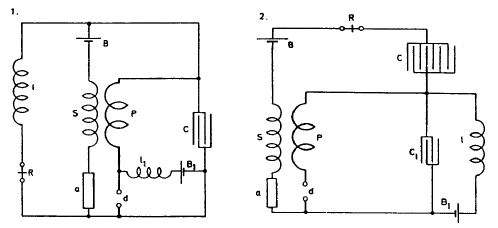
An arrangement as illustrated in 1. was made to see whether excitation (preparatory) could be conveniently effected by shunting around break d a
circuit including very high graduated self-induction l1 with battery B1. This worked fairly well.
To avoid certain disadvantages in previous similar forms of apparatus — as the permanent closure of condenser — a number of modifications based on the use of two condenser was resorted to and
experimented with, some of which are illustrated in diagrams following.
In Diagram 2. two condensers C and C1 are placed in series, one of them being shunted by graduated self-induction l and battery B1. The other condenser C, being larger, allows the current from
battery B to pass through break and coil l when device a is excited. Not very good. A modified plan is illustrated in 3. In this case the auxiliary battery B charges the two condensers C and C1
in series, whereupon one of them is discharged through the break d. This is fair.
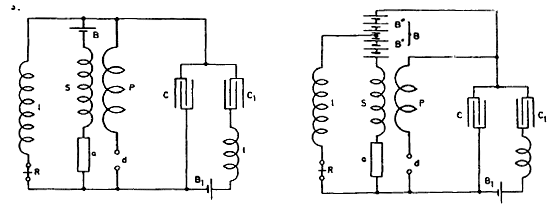
In 4. the battery (main) is so placed that a high e.m.f. is charging the condenser yet current through the sensitive device is small.
Colorado Springs
Aug. 11, 1899
Measurement of capacity of the new condensers prepared from Maniton Water bottles.
With the exception of three tanks in which bottles with green glass were used all the remaining bottles were of dark glass. The test did not show much difference between the two kinds of glass
and all the tanks separately measured were found to be, after proper filling in of the solution, of the same capacity or very nearly so. All the bottles were first connected in quantity and the
capacity compared with that of 1 /2 mfd. standard condenser.
The deflections were almost exactly as 36 : 44, 36° for the 1 /2 mfd. and 44° for the bottles.
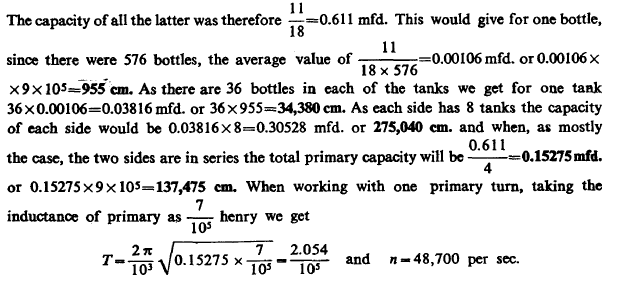
Other modifications of signalling apparatus experimented with.
Several ways of providing for initial excitation when using oscillatory transformer principle are illustrated in diagrams which follow:
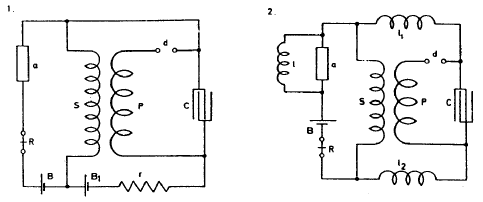
In the first diagram the excitation is provided through auxiliary battery Bt the strength of which is regulated by adjustable resistance
(inductive or ohmic) r. The two batteries B, fl, are so connected that they join in straining device a.
In Diagram 2. an inductive resistance very high is connected around device a and coils /, l2 are also employed to prevent the secondary S being closed and potential diminished through
comparatively large condenser C. The inductance / and also l1 l2 are adjusted.
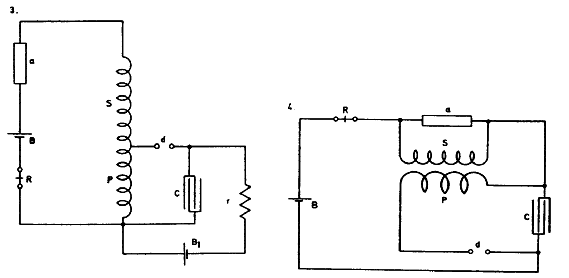
Again in Sketch 3. is shown a plan convenient to use when the secondary is wound in one single layer on a drum. A part of the secondary is made
to serve as a primary through which condenser C, loaded to the desired point by battery B1 (graduated by resistance r) is made to discharge. In this manner it is easy to adjust the action of the
secondary on device a.
In Diagram 4. is illustrated a simple way experimented with before which secures good results. This to follow up.
Next Page
Colorado Springs
Aug. 12, 1899
Further modifications in signalling apparatus.
Figs. 1. and 2. show ways of securing initial excitation by means of very high inductance £ connected as shown.
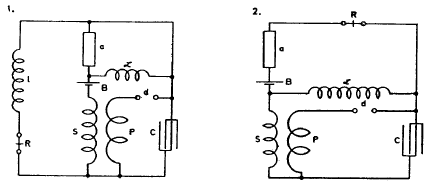
Diagrams 3. and 4. illustrate similar plans of connection. In the former the battery B is in the main circuit, in the latter in a shunt to device a.
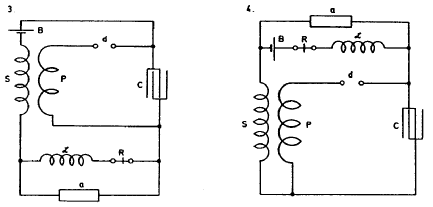
In Figs. 5. and 6. other modified connections are shown. In 5. an auxiliary secondary S1 with battery and relay is connected around device a which is excited by main secondary S.
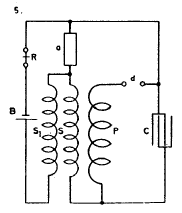
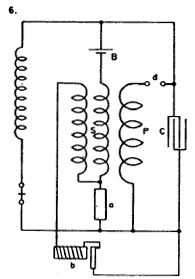
In 6. a similar connection is used with a buzzer b to excite device a through secondary S.

Figs. 7., 8. and 9. again illustrate other arrangements in which two batteries were employed, one generally to secure initial excitation.
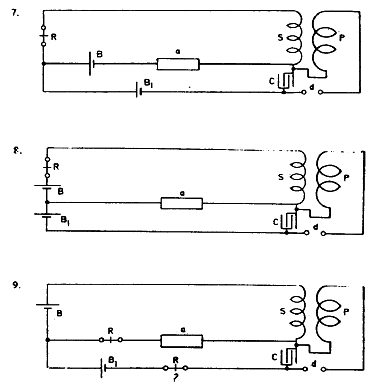
Colorado Springs
Aug. 13, 1899
Experiments with oscillator 35—35 1/2 turns. Tension on Westinghouse Transformer 15,000—22,500 volts. Supply transformers connected 100 volts. 1 primary turn, all jars tension 15,000 volts,
effects would indicate capacity too small.
To ascertain this the connection was changed to 2 primary turns in series and 1/4 capacity (2 tanks). The capacity was now varied but resonance effects moderate. All experiments show clearly too
much capacity and comparatively little self-induction in secondary. There is a large movement in the wire, but pressure can not appear on end as it would in the absence of capacity.
By adding capacity on one end better results indicate that this view is true.
One of the balls 38 cm. on end results much better, sparks on arresters much stronger.
Two balls connected — effects still stronger, sparks livelier on arresters but the tension still too small. Needs much more capacity on the end to overcome internal capacity distributed along
cable.
Now again changed to one turn as oscillation much better. The extra coil was added and adjustment of capacity made. Best results with 3 2/3 tanks capacity on each side. An empty tank placed on
top of the coil for capacity. The effects with 22,500 volts on W.T. remarkable. The streamers very rich red, quickly darting up to 9 feet long. Many brilliant sparks would jump up to a 10 foot
distance.
Colorado Springs
Aug. 14, 1899
The following arrangements with two sensitive devices were the subject of consideration and experiment today:
This disposition (1.) though it worked fairly had the disadvantage that a diminishing of resistance of device a was not very effective in increasing the charge of the condenser, but by making the
secondary and relay circuit of very high inductance and resistance this defect was to a degree remedied.
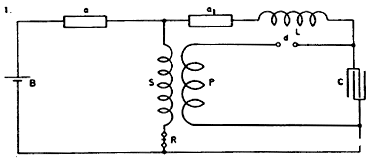
By changing connection to the one indicated in the second diagram the condenser was stronger and more effectively charged upon the falling of the resistance of either of the devices a a1.

The conclusion arrived at from many experiments with two devices, which seem to indicate that two such sensitive devices are better than a single one as regards sensitiveness, was that the devices should be arranged as in Sketch 3 so that a change in one will produce a change in the other which in return should react upon the first and so on. This general scheme is to be further considered.
Other arrangements of apparatus with open secondary for exciting sensitive device.
In this plan (4.) the secondary S is connected to the terminals of sensitive device a through a small condenser CCX. A very small condenser is sufficient to cause the excitation.
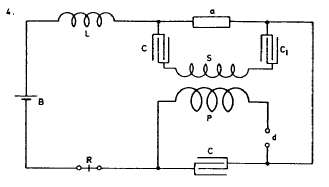
This is a modified arrangement (5.) there being only one condenser and besides a very high self-induction around device a to provide for initial excitation when device a is originally of practically infinite resistance. The relay R may be placed around device a instead of self-induction l.
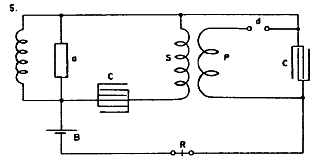
In the diagram below (6.) is shown a manner of connecting apparatus to a circuit Lx C, which is adjusted to be in synchronism with the primary vibrations of the oscillator and excites device a.
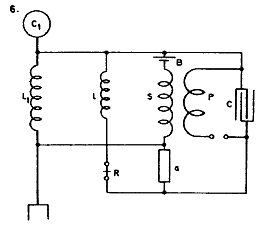
Again in Diagram 7. a special synchronized circuit is done away with, the secondary itself being adjusted to the primary vibrations. The plan adopted in New York apparatus of winding secondary and primary on a large drum (8.) serving at the same time as table is best. Tuning is easy, apparatus cheap, a large amount of copper may .be easily placed in the synchronized circuit.
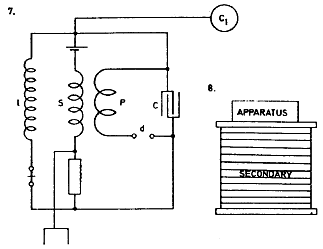
Colorado Springs
Aug. 15, 1899
Change of secondary of oscillator to adapt it to the jars. Capacity for one tank 36 bottles 0.03816 mfd. Two sets of
tanks, 8 in each, give in series a total capacity of 4 tanks that is 0.15264 mfd.

Now resonance of present secondary 5280 feet was obtained with total capacity of 6 tanks instead of 4. Reducing the figures for length we should
have for smaller length a capacity larger in proportion  , or 1.11 that is instead of 4
tanks we should have had 4.44 for 5280 feet. The required length for 6 tanks capacity. This length would be
, or 1.11 that is instead of 4
tanks we should have had 4.44 for 5280 feet. The required length for 6 tanks capacity. This length would be

With this length the oscillator will require same capacity as extra coil and good results may be expected.
Colorado Springs
Aug. 16, 1899
Owing to high self-ind. of secondary of W.T. and large ratio of transformation and also great inductive drop in supply transformers (which are poor) of inadequate capacity desirable to work with
two circuits as adopted in small size oscillators with mercury break.
Various advantages are thereby secured chief of which: double break number, smaller resistance in gaps and increased capacity of W.T. for charging condensers. Connections may be as illustrated in I and II.
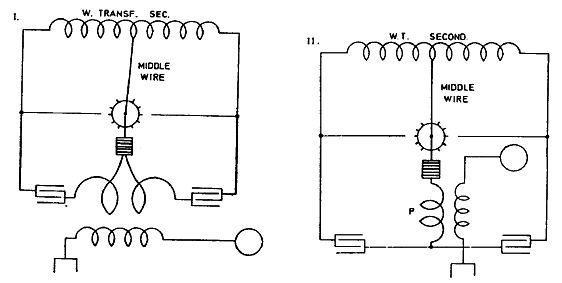
This connection shows well with small oscillators provided the short circuit of secondary of supply transformer avoided.
Colorado Springs
Aug. 17, 1899
In the working of transformer as before illustrated I. or II. the short circuit of secondary is an inconvenience which is overcome by having a few teeth at a good distance, but this diminishes
the number of breaks which it is practicable to secure. Another way is to adopt a process also successful with small oscillators — of charging the condenser, next disconnecting the same and
finally discharging. But this has also the disadvantage of reducing the number of breaks.
Plan here illustrated seems free of these objections:
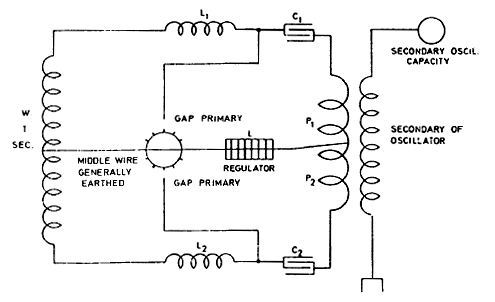
Here the short-circuit is avoided by the use of self-inductions Ly and L^ which must be well insulated to stand high tensions. A single
self-induction inserted in the middle wire may also be used with like effect.
Colorado Springs
Aug. 18, 1899
The best result with apparatus at command, that is, 3 supply transformers, West. Tr. and condensers newly constructed is obtained by employing two dielectrics giving total capacity of condensers
equal to that of four tanks. This allows working with 22,500 volts safely.
The results will probably be the same with 45,000 volts connection and 4 dielectrics but then capacity is only one tank and sparks in primary are longer and more difficult to control.
With connection illustrated before (Diagr. I or II) it is also practicable to work whh 45,000 volts total by connecting the tanks on each side in a series so that capacity of each of the two
alternately working circuits is equal to that of two tanks. That is 2x0.03816=0.07632 mfd.
With one primary turn this gives

Colorado Springs
Aug. 19, 1899
Previous experiments showed in a number of cases good results with connection and quantities as indicated: Capacity in primary circuit 6 tanks on each side; 1 turn primary about 3/4 of self-ind
regulator.

From reaction of capacity on secondary of W. Transformer it was probable that more capacity was required, but the transformer was overloaded
when more tanks were joined.
With 22,500 volt connection the overload was very marked and lamps would go down 50%. When the connection was changed to 15,000 volts the lamps instead of falling would go up some 35% — 40%. No
other change in capacity or otherwise was made and this showed that effect not merely due to an interaction and self-induction and capacity but that the e.m.f. was also a determining
factor.
With the first connection effects were brilliant, sparks in gap 8—11 feet according to charge and adjustment. Above considerations led to changing to two turns primary. Capacity first 1 1/2 tanks
on each side. e.m.f. on transformer 22,500 V would go up possibly 25%. Capacity was gradually increased to 3 2/3 tanks on each side when with Regulator all out the effects were best. The rise of
e.m.f. about 35—40%. The sparks were curiously fierce, no direction seemingly, darting pass terminal l.
(Here fire started on coil).
Colorado Springs
Aug. 20, 1899
Exp. with oscillator secondary 29 turns continued to ascertain free vibration more exactly. Connection 2 series on each side, 4 dielectrics, total capacity 1 tank. Tension on Westinghouse
Transformer 30,000 volts approx. Spark gaps outside about 3" each, inside one turn. Results on the whole less satisfactory showing clearly that difficulties increase as tension becomes greater.
Middle box on one side broke down, sparks following through the mahogony frame to a screw and jumping from this a distance of 4".
This can be only due to rapid vibration and suddenness as tension on that box only 15,000/2 volts. There are some doubts as to the distribution
of e.m.f. in condensers in series when vibration takes place. Strong (probably inductive) drop on supply circuit (exceptionally so).
Observation: When lamps increase strongest on supply circuit then spark will not jump over the gaps, showing that then e.m.f. on secondary of W.T. smallest.
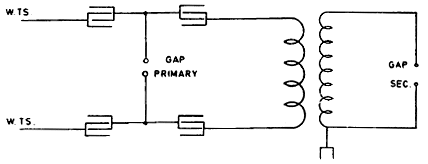
Connection was changed to that indicated in sketch for the purpose of avoiding effect of short circuit of secondary of W. T. through primary
arc. Absorbed energy was great. Sparks on switch serious. Lamps would go up very much when arc would break through. But general results not satisfactory. The condensers directly on W.TS. take
strong current.
Colorado Springs
Aug. 21, 1899
Other experiments with oscillator secondary 29 turns. Simply spark gap. Connections used:
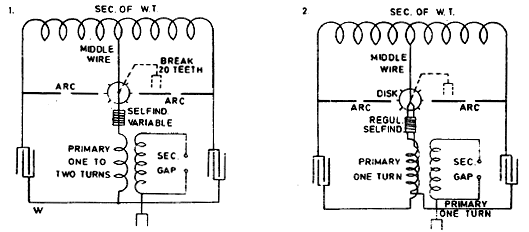
Plan illustrated in first diagram was adopted to obtain double number of breaks with same disk and securing other advantages. Also to better utilize W. Transformer. It was found that when one side on it worked remarkably well, sparks about 4 feet. The tension on each half of transformer being 11,000 volts approx. when both parts on interaction hurtful. The chief drawback being short circuiting of secondary.
The arc was snappy and loud indicating short circuit and rapid vibration through wire W. The secondary discharge was thick but spark not long
about 3 feet. All tanks were in on either side and the transformer charged them full when separate. When both parts on evidently the secondary of W. T. was overloaded.
In arrangement illustrated in 2 short circuiting was largely overcome but the short circuit of secondary of W. T. remained the same. The results were similar no matter in what direction both
primaries were connected. The necessity of overcoming short circuit in both arrangements became soon more and more important.
To improve — arrangement illustrated in Diag. 3. was used. It proved itself more economical but the amount of energy was limited. The hurtful short circuit was entirely obviated and the lamps
were less affected.
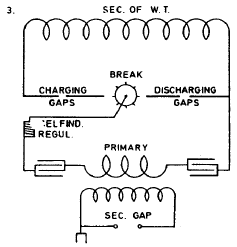
Colorado Springs
Aug. 22, 1899
Arrangements for telegraphy tried. In these the chief point was to keep one end of secondary spool open so to allow full rise of pressure on this end. The sensitive device, one of the before
described, excited fully resistance 12 ohms approx. Not excited over 100,000 ohms.
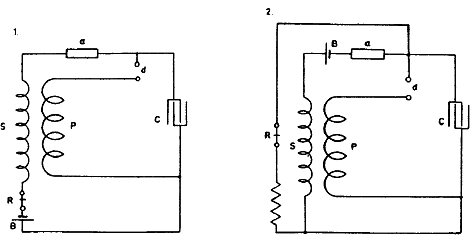
In Diagram 1. first experimented with, a disadvantage was found to exist: namely, the receiver R was operated through the break device d. This inconvenience was done away with in arrangement illustrated in Fig. 2. which allowed more sensitive-adjustment of Relay R and the apparatus worked better.
Capacity of condenser was varied up to 20 mfd. with changing success. Best results seemingly with small capacities up to 1 mfd. Secondary about
4,000 turns, primary Lamp cord No. 10 turns 28. The apparatus responded freely to small pocket coil at a distance of several feet with no capacity attached and no adjusted circuit. Consequently
will go at great distance.
In these arrangements, as in the previous ones involving the same principle, the effect on the sensitive device is accumulative and a difficulty arises that namely the sensitive device will not
readily de-sensitive. By inserting large resistance r in circuit with receiver R this effect upon the latter is largely reduced as the current through receiver and device is kept to a
minimum.
By adjusting speed of rotation of sensitive device the inconvenience is also overcome.
Colorado Springs
Aug. 23, 1899
Experiments with new extra coil placed in center of primary. The spool 75" diam., 12 feet high, 160 turns in all. 120 turns wound close together in the adjacent grooves and 40 turns the upper
ones at three times that distance, that is, two empty  grooves between each two turns. Breaks on two sides alternately approximately 2,400 breaks per sec. On top (free end) ball of 38 cm. capacity. Resonance was obtained with 5 2/3 tanks on
each side, one turn primary, self-induction in box 4 turns.
grooves between each two turns. Breaks on two sides alternately approximately 2,400 breaks per sec. On top (free end) ball of 38 cm. capacity. Resonance was obtained with 5 2/3 tanks on
each side, one turn primary, self-induction in box 4 turns.
Gaps were 1 1/16 on each side plus gaps in box 2 turns. Tuning remarkably exact, 1/8 turn of self-ind. box reducing the effect very much. When exactly 4 turns in box, sometimes streamer 8 foot long would shoot out from a defective spot on wire. The ball on top reduced streamer capacity and prevented streamers from coming out all along the top turn as usual. The spark gaps work extremely well, loud explosive character indicating good vibration.
Such sparks are always noted when secondary well tuned. The system worked economically, the lamps in supply circuit not falling at all. The
earth connection now was taken off and oscillator of same period — (the secondary 29 turns connected). Both had now same period, the secondary and the extra coil. On first throw of switch a spark
darted to roof above from the ball and the cord caught fire. Fortunately, it was extinguished before doing damage.
This accident showed that better provisions against such an accident have to be made. The roof to be fixed with a guard of wire gauze which would prevent the wood from catching fire through
sparks darting up. As it was dangerous to work further without guard against such an accident another ball 38 cm. supported on high was connected to earth and placed at varying distances from the
ball on the end of the extra coil.
The sparks jumped from the upper turn of the coil to the Earthed ball and sparks of seven feet were easily obtained. It was evident that the
distance could be much increased but this was deemed hazardous. As it was the sparks of seven feet were probably the longest obtained from such large balls or surfaces of such small
curvature.
The connection of the primary circuit was now changed, two turns being used in series. This reduced the period to one half and it was thought that this would respond to the fundamental note of
both secondary and extra coil. Experiments were disappointing for the display was not remarkable, the sparks were up to four feet long but much thicker and whiter. I believe that the true
vibration was not struck but skipped.
As tiftie pressed, further experiments with the view of ascertaining the fundamental note were postponed and the first connection with one primary turn again made. Both balls were now connected in multiple to top of the coil and to the upper rod of a spark gap, the lower rod being earthed. There was no danger of setting fire in this way. The display was remarkably noisy. The sparks were up to 14 feet long, snapping quick,-explosive and very white.
Sometimes streamers would shoot out fully 11 feet. Often several sparks at once. No particular direction in striking. The capacity in the
primary circuit was varied up to 8 tanks on each side. Always striking effects. The ground wire had no capacity and no sparks were seen on arresters but before, with only one ball and no
streamers, sparks of 5/16" were drawn from water pipe in distant room.
Colorado Springs
Aug. 24, 1899
Experiments with new extra coil and oscill. secondary 29 turns continued. The ball on top was disconnected and a bare copper wire run around the upper rim of the coil to produce streamers.
Capacity in primary circuit on each side was 5 2/3 tanks with 4 turns self-induction box in. It was not advisable to work because by the throw of switch some streamers would dart up to the roof a
distance of 12—13 feet. The other ball used in previous experiments was placed at a distance of 11 feet from coil and also it was unconnected — except that it had a wire of about 8 feet hanging
from it —the sparks would fly to it from the rim of the coil.
A curious feature is that the streamers are very sudden, explosive. This is due probably to the suddenness of the break. Occasionally an unusually long streamer would shoot out. This probably
owing to resonance of break or temporarily short circuit over break, probably the former cause responsible. Desirable either synchronous break as worked in New York, or a very rapid one. The
speed of motor is to be increased to double for this purpose.
Coil was disconnected from the oscillator and connected to the ground. The period corresponded to that of the primary with 7 tanks on each side, no self-induction. 5 2/3 tanks, 4 turns, and 4
tanks and 9 turns. Thus 3 tanks made only a difference of 5 turns on self. box. With four tanks tuning wonderfully close, twice it was missed before finally located.
(The roof of building was fixed today, cords done away with)
Colorado Springs
Aug. 25, 1899
Experiments continued with extra coil on wooden frame 12 feet high, 6 feet diam., 160 turns No. 10 wire. A bare copper wire was supported on top, the wire forming a circle not closed of about 8
feet diam. Another copper wire was supported 4 feet below and at a distance of about 13 feet, all around the diameter of circle being approximately 34 feet. This circle (also not closed) was
connected to ground.
Very powerful streamers were produced sometimes extending the full distance between the wire circles, but still they showed tendency upward in spite of presence of ground circle. Often sparks would pass in curved paths between the two circles. During the display no sparks on arresters, small sparks in adjacent room from water pipe. Capacity on each side from 5 2/3—7 tanks.
Longes streamers with former value. The circle of 8 feet diam. was then taken down and another one about 10 feet placed on top of coil.
Streamers now showed some tendency to pass to grounded circle. Sparks to the latter more frequent and brilliant. No play on arresters and small sparks in adjacent room as before.
One of the balls was now connected to the ground but although sparks of eleven feet jumped to same no sparks on arresters. The vibration was evidently slow, that pertaining to extra coil and
harmonics in earth wire from ball did not preponderatingly appear.
Colorado Springs
Aug. 26, 1899
Experiments with oscillator secondary 29 turns and extra coil last described continued.
The alternate motor was put on 200 V with self-ind. coil in series, latter regulated so that motor could drive disk of break with twice the speed, that is 4200, the speed of motor being
approximately 2100. This gave, since disk" had 20 teeth and two alternately working breaks,  breaks per second.
breaks per second.
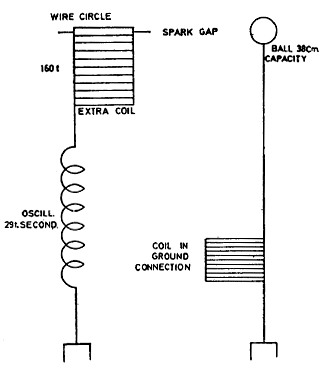
In the first trials connections were made as in sketch. The spark gap between wire circle on top of extra coil and ball supported was 8
feet.
Sparks passed readily and the display on arresters was remarkable. Thick arcs joined the arrester contacts on both lines and jumped also through one of the choking coils. This was the strongest
effect so far on arresters.
A choking coil was now inserted in ground connection to see whether by lengthening the period of the earth wire the sparks on the arresters would be diminished. This coil was 34" diam. wound with
one layer wire No. 16, thick rubber insulation (layer 10" high) 50 turns. This coil did not weaken the effect much probably because frequently sparks would jump between the turns.
Otherwise it was surmised that the vibration of the secondary itself with the extra coil might be responsible for most of the e.m.f. generated
between the ground and line. Singularly, despite this strong effect as evident from arresters but very small sparks were drawn from water pipe in adjacent room, this seemingly indicating that in
this experiment the earth acted as a nodal region.
The conclusion from these first experiments as to the efficiency of the break was that double number of breaks decidedly better. Nor did it short circuit the transformer more because of the
increased number, but on the contrary less as far as could be judged from the lamps on the supply circuit which went up as the switch was thrown in.
It was evident, furthermore, that the large circle of wire which was before supported above the secondary and grounded, strongly interfered with the action on arresters because it allowed local
vibration which was not effectively transferred to the ground and the air.
To decide surely whether, and to what extent the long waves were responsible for the difference of pressure evident on the plates of arresters, the secondary and extra coil were connected as in
sketch. In this connection only long waves could be effectively transmitted upon the ground. It would have been desirable in this and previous experiment as well to take off the wire circle and
substitute a ball on top of the extra coil but this being inconvenient the circle was left.
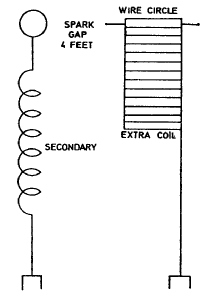
As the extra coil had now only a small initial pressure the e.m.f. obtainable in the spark gap was much smaller and the gap was reduced
therefore to 4 feet at which distance sparks readily jumped. The play on arresters — though weaker
— took place nevertheless, this important result showing that waves 3—4 miles long could produce these e.m.f. sufficient to cause the sparks to pass between the plates of the arresters. Now it is
important to consider: is the earth a nodal region or the crest of a wave (that is, the region immediately adjacent to point of attachment of secondary to ground).
If a nodal region then the e.m.f. set up at the small distance of 60 feet separating the point of attachment and the ground of lightning arresters was only a small part of the total e.m.f. But if a crest then the e.m.f. set up and causing sparks was nearly the total e.m.f. produced by the apparatus. If a nodal region near the point of attachment of the secondary, then at a distance of about 4000 feet there must be a strong effect, but if a crest, then at that distance there would be no effect. This is to be decided by further observations.
The connection was now changed to that indicated. It was thought that both vibrations would cooperate and produce a stronger effect, but it was at once evident that so long as streamers (which were about 10 feet) formed on top of the extra coil the effect must be smaller, since all energy came from the secondary and the streamers caused loss. A condenser ought to be used instead of a gap to make such an arrangement most economical.
Although owing to nodal point the length of spark in adjustable gap was small, the display was strong on arresters, but not nearly as strong as when the extra coil was entirely left off. In the latter case the action was very rigorous so that often flames would form on arresters showing short circuit of dynamo. Also the other choking coil would break through. Evidently then the extra coil did not in this instance prove useful in intensifying vibration contemplated.
Experiments continued: extra coil was now lowered 2 feet nearer to ground, distance now being about 4 feet from floor and 5 feet from
ground.
Capacity 5 2/3 tanks on each side in primary. The transformer (W. Co.) works very well (22,500 volts). The lamps go up 35—40% when the arc does not break through, the gap being made large for
this purpose, and when the arc breaks through they still rise slightly above normal.
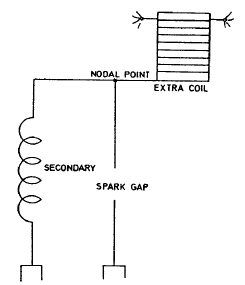
The gaps outside 1 1 /4" each approx. Inside 1 1 /2—2 turns. Streamers produced were still more powerful being made so owing to approach of
secondary. They would dart out to a distance of 12 feet sometimes.
Important. Strong arcing on arresters, although no spark would pass to the ball used before, which was placed at a distance of about 9 feet. Could
the sparks be produced by static induction upon wire through the air and not chiefly by conduction through earth?
To test this a coil 50 turns referred to before was inserted in the ground wire of the lightning arresters. It was expected that it would weaken discharge across, but did not probably because the current was small and the choking action likewise for this reason.
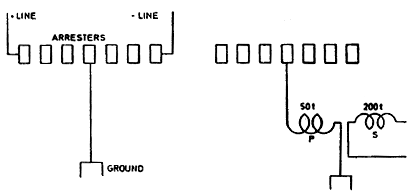
To see whether there is some current passing through the earth wire to the line, another coil was placed in inductive relation to the ground
wire coil and strong sparks 3/8" were obtained on former. Sparks, lively 3/8" approx., were also obtained from coil P. Note: Sparks to ball sometimes, at other times streamers would dart past the
ball. The streamers horizontal when sudden, when switch was held longer they would waver. In last experiments only half of wire circle on top of spool was used.
Colorado Springs
Aug. 27, 1899
Older plans experimented with and modified arrangements of apparatus for wireless telegraphy further considered.
These connections used to relieve the sensitive device from the strain of the battery after excitation. The necessity of doing this leads to the reconsideration of an old plan experimented with
in New York which consists of placing the sensitive device between condensers in circuit so that each time only one current impulse can pass through the device.
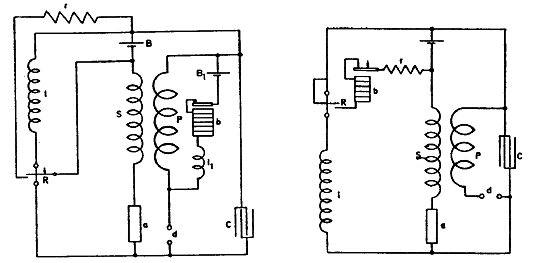
This is illustrated in a general way in the little diagram below. The battery strains the device a through the condensers C Ct but when, upon
the device a becoming excited, the condensers are suddenly charged the current impulse caused by the charging automatically stops. It is then necessary to reverse the mains, or discharge the
condensers to make the apparatus ready for a second operation. This plan allows use of very high pressure on the sensitive device which should be of great resistance.
Plan in last diagram illustrated consists of raising, by means of inductances l l1 condenser C and break device d, the e.m.f. of battery B so far as needed to bring the device a to the
point of nearly breaking down. The quantities should for a better result be adjusted as usual. Both relay coils R R and inductances l l1 are placed symmetrically.

Colorado Springs
Aug. 28, 1899
Experiments with oscillator, secondary 29 t. in series with extra coil before used (160 t) were continued tcday and showed the following: Capacity in primary being from 5 2/3—8 tanks on each
side, varied to observe shifting of nodal point, play on arresters and behaviour of streamers and spark discharges.
A half circle of bare wire on top of extra coil was left and in addition a larger half circle of bare copper wire (No. 14) was supported on wooden strips 4 feet below the former half circle. Both
the bare wires were connected to the free end of an extra spool. The lower half circle was 9 1/2 feet away from a circle of the same bare wire which was supported on oscillator secondary frame
and formed the terminal of the secondary.
Abundant sparks and streamers were produced. The play on arresters was also observed at each throw of the switch. The rain and lightning were just beginning. Magnificent intense white light witnessed below Pike's Peak, something very unusual. It resembled a white hot silver furnace. The lightning on the mountains was very frequent and the discharges of unusual brilliancy. Twice a curious phenomenon was noted. Lightning striking in one part of the mountains from cloud to earth, there was seen in another part a few miles away from a high peak a lightning discharge which to all appearances came from the peak to the cloud.
The discharge was much thicker at the root and branched out towards the sky spattering itself in many branches and disappearing in fine streams. The astonishing phenomenon was witnessed a second time and subsequently, though there was much uncertainty about the direction in the latter cases; a few times a similar discharge took place from other peaks. Is it possible for a discharge to go from Earth to cloud? As far as the visual impression is concerned there can be no doubt.
The discharge in all cases followed a preceding lightning discharge in another region, and apparently from cloud to earth.
Perhaps it can be the effect of an intense vibration started by the first discharge which results in another discharge towards an oppositely
charged cloud. The clouds were unusual in configuration and grouping. A large portion of the sky was quite clear. The wind at times was very strong. An instrument by its constant play indicated
strong electrical disturbances through the earth, even when there was no display of lightning as far as could be seen or heard.
After some time the experiments were continued and presently it was observed that the usual sparking on the arresters was no longer to be seen when the switch was thrown in. The only change made
was to take the upper half circle off leaving only the lower one.
This gave a smaller streamer surface and consequently longer streamers. The display was fine. In order to see whether the upper half circle of bare wire was responsible for sparks on arresters the wire was replaced but still no result. Then it was thought that other causes for the sparks not appearing were responsible and everything that could have the slightest bearing upon this was investigated. Still nothing was arrived at. The sparks did not appear no matter what change was made in the adjustment of the vibratory circuits. What could be the cause?
The only explanation at present is that the roof was rendered slightly conducting (although there was little rain in this locality) and that
this produced the change. Important to find out. Observation: The lightning lighted two houses about two miles away.
Colorado Springs
Aug. 29, 1899
Experiments were made with receiving apparatus comprising an oscillator with mercury break and two devices of the kind before described. The oscillator was of a later 2000
pattern, mercury break by 2000 rev. per minute gave x 24=800 breaks per second, 60 there being 24 teeth in the pulley. The condenser in the instrument was 1 mfd. approximately. The instrument was
used as a sender and the experiments were intended to test its efficiency as a receiving apparatus.
Accordingly, the connections were made as in sketch, the method of magnifying by oscillating transformer being made use of to increase sensitiveness. As far as practicable all connections and parts of instrument were used.
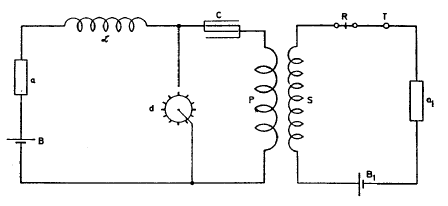
The connections of primary circuit including break remaining the same, only a battery B. (1—4 cells dry O.K.) and sensitive device a
being inserted instead of a generator. In the high tension secondary were connected a receiver R (relay), telephone T, battery B, and another similar sensitive device a1. The motor was
driven from a small direct current generator which in turn was driven by the alternate current motor usually employed to drive the break disk of the large oscillator. This apparatus was extremely
effective, merely the addition of small capacity on a was sufficient to make the receiver respond. Evidently this effectiveness is due to the efficiency of the oscillating transformer and
excellent working and high frequency of the mercury break.
Experiments were continued for a short while with oscillator and extra coil. The frame of the secondary was repaired and a board for connections of the transformers put in place and other work
took most of the day, it being late when the investigation was resumed. A netting of wire gauze (iron) had been placed around the opening of the roof to diminish danger of inflaming the
building.
But on the first throw of the switch the streamers and sparks darted against the netting a distance of about 12 feet and sparks were seen to go from netting on to the wooden structure of the roof. It was advisable to stop work and the roof was removed. Now the ball on top of the extra coil was connected to the latter by a wire No. 10,40 feet long, very heavily insulated with tape over the rubber covering.
One turn on the outside and nearly another complete one in the inside were made and the end of the wire connected to the ball. The latter could not be lifted up and the experiment was tried with the ball in place. The streamers now appeared on the ball copiously when the current was turned on, their tendency being to go straight up into the air.
The longest were only about 4 feet as it was deemed unsafe to strain the apparatus higher until further provisions for safe working were made.
The lightning arresters were observed but no sparking. This showed that the absence of sparks was not due to rain or moisture as was concluded yesterday, since the weather was very warm and
dry.
Colorado Springs
Aug. 30, 1899
Experiments were resumed with resonating coil to be used in connection with receiving apparatus. The coil was wound a week before on a drum 25 1 /4" diam. of bicycle hoops and a thin board, the
idea carried out before in New York being followed to make the drum with coil serve, at the same time, as a table for instruments. The drum was 3 1 /2 feet high, only partially wound on upper
part.
The wire was ordinary magnet wire No. 20, 516 turns. The self-induction was approximately calculated from the following data: diameter of drum 25 1 /4" or 64 cm.; length of wound part 20" or 50.8 cm.

The coil was now tuned with oscillator in response to a somewhat higher note with small capacity on free terminal, the other being connected to
the water pipe. Sparks of 3/4" were obtained while from the water pipe alone a very minute spark, scarcely perceptible, could be obtained. Induction from primary being carefully eliminated, the
sparks were still 3/8" long and white.
Colorado Springs
Aug. 31, 1899
Experiments were continued with the extra coil and secondary conditions as before. The ball in the center was connected again to the top of coil and elevated a little above the roof, the latter
being opened as wide as possible. The experiments were begun in the afternoon while the Sun was very bright. Scarcely any streamers from the ball could be seen but occasionally sparks would go to
the roof from the center wire leading to the ball.
The distance was 12 feet. There was a pronounced tendency in the sparks to fly to the roof which might have been due to dampness of the latter owing to rain the day before. During the few trials
which were cut short because of the danger threatening from the sparks, the lightning arresters were observed but no spark was noted. In the forenoon the mains were tested and it was found that
one of them was fairly grounded which to some extent also made the other defective. This probably was the reason why the sparks no longer appeared on the arresters.
A number of curious observations were made during the trials with the elevated ball. A fly was seen to light on the top of the ball and when the switch was thrown in the insect disappeared
evidently thrown off with great force. Another such insect alighted on the under part of the ball, and the current being thrown in just about at the moment when the fly started off, the fly was
seen to fall from a distance of about one foot from the ball straight down to the floor, evidently killed in the flight.
Still more curious it was to see a moth at a distance of fully eleven feet from ball, near to the wooden frame fall straight down as the switch
was thrown in. The strongly electrified ball evidently exercises a strong attraction on a small insect which is drawn towards it every time the ball is electrified. This was repeatedly
tried.
An observation less amusing but more useful was that when the ball with its circuit were well tuned and no streamers appeared, owing to good insulation of leading cable — there was a decided
tendency to break the jars in the primary. Evidently, when there are no streamers the vibration is effected with lesser loss and hence there is a great rise of e.m.f. reacting upon the primary.
This at least appears the most plausible reason for the phenomenon observed.
Light seems to interfere decidedly with the streamers from ball and wire and it is also unmistakably noted that the noise of the discharge is lessened when the sunlight falls upon the
apparatus.
Spark gaps were established in a number of ways as by connecting both coil and secondary to ground and each to one of the balls and establishing a spark gap between the latter.
Finally the ball was again connected as before and elevated, a point being first placed on top to facilitate formation of streamers. It was curious to observe that the streamers were carried away
horizontally, and eventually blown out by the wind. The resonating action was strong but the length of the streamers could not be estimated. From the leading cable the discharge would sometimes
leap to a distance of at least 10 feet. The action of the wind suggests the idea of preventing the formation of wasteful streamers by a current of air.
 Inventions & Experiments
of Nikola Tesla
Inventions & Experiments
of Nikola Tesla